Daxia
Democratic Republic of Daxia 昆仑 共和国 | |
|---|---|
Motto: The sun never sets on Daxia | |
Anthem: March of Joy | |
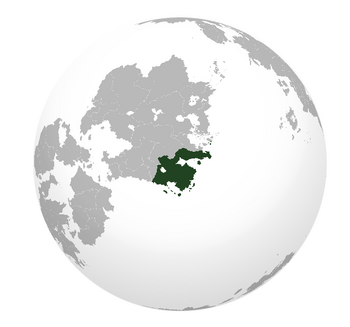 Daxia and its territories | |
| Capital and largest city | Mirzak |
| Official languages | Daxian |
| Ethnic groups |
|
| Religion | None |
| Demonym(s) | Daxian |
| Government | Republic |
• Chancellor | Prib Dodd |
| Legislature | People's Assembly |
| Establishment | |
• End of Old Night | 305 BCE |
• Era of Chaos ends | 423 CE |
• Heavenly Empire established | 645 CE |
• Glorious Revolt | 1957 |
• Demcratic Republic of Daxia | 1992 |
| Population | |
• Census | 698,168,695 |
| GDP (nominal) | estimate |
• Total | $26.6 trillion |
• Per capita | $36,222 |
| Currency | Lire (LIR) |
| Driving side | right |
| Calling code | +646 |
| Internet TLD | .cro |
Daxia, officially the Democratic Republic of Daxia is a state located in southeastern Audonia. It borders Rusana to the west, Canpei and Huoxia to the north and the Taizi Sea to the east and south. Daxia also has territories in north Crona and a smattering of strategic island holdings. Its capital and largest city is Mirzak, a city with a population of over twenty million and the political and economic heart of the country. The largest and dominant ethnicity is the Daxian people, which number above 700 million people making it one of the more numerous groups on the continent. The Daxian language is the only official language although Rusani may be spoken and taught locally in certain provinces. Daxia is a medium income country with large industrial, agricultural and technological sectors, with economic growth seeing an uptick in recent years especially due to the opening of new markets in Crona and the flow of cheap raw materials from the colonies. Daxian mercantlism has seen Daxian companies spread out across the globe to open subsidiaries and acquire local firms, often with off the books government support.
Foreign policy-wise, the Daxian often like to take the long view and be cautious, which has led to accusations of being fence sitters and unprincipled in foreign affairs. Despite this, Daxia is considered a major power broker at the League of Nations where its diplomats are always carefully maneuvering and negotiating to push through or sink various initiatives. Daxia is also a nuclear power, developing its own arsenal in the 1960's and demonstrating its willingness to adopt a first strike policy, most recently in the atomic bombing of Shimrra. Politically the country is dominated by the Party of Daxian Democrats which has won every election since Linge Chens election in 1992. Internally Daxia is a vertically arranged state, with an all powerful office of Chancellor at the cusp wielding absolute power and authority, with virtually no checks and balances. The rule of the PCD is safeguarded by a potent and cruel military and pervasive security forces which keep a tight, choking grip on all sectors of society, even abroad. Historically, relations with its neighbors have been plagued by conflict and mistrust but this is changing in recent times. The people of Daxia are highly suspicious of foreigners and their barbaric customs and hold fast to several xenophobic attitudes.
Etymology
The etymology of the name Daxia is well known to scholars. Daxia derives from the characters 大谐 which transliterates to Da Xié meaning Great Harmony; this was the name of the first recorded imperial dynasty to rule significant parts of Daxia. The first instance of the name Daxia appaearing in literary sources is from scrolls detailing the tribute sent by Emperor Balwa-Hu of Metzetta.
History
Antiquity
Xie Dynasty (2,500 BCE- 685 BCE)
Era of Chaos Period (685 BCE-475 CE)

During this era several states vied for supremacy over one another. The strongest states were Cao, Mung, Zuo, Chen, Yang, Liao and Jin(later divided into Upper and Lower Jin). Other states existed during the period but were much shorter lived.
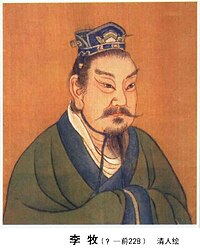
The balance of power often changed as temporal alliances were forged or broken. The appointment in 105 BCE of Prince Dorgon as chief minister of Yang and his military reforms mark the start of the 'Era of Yang Domination'. For most of this period Yang maintained a military alliance with the southern state of Cao, which enabled it to overtake Zuo by 12 BCE. Wars with Chen would last until its final destruction over 200 years later, with Yang reaching its greatest extent by 235 CE.
Despite its expansion, Yang could never comprehensively defeat its other neighbors and was riven by dynastic infighting that would fatally weaken it and give openings to rival states. As Yang became increasingly embroiled in wars on all sides, Cao eventually broke off its long standing alliance. During 368 CE, King Shisheng of Cao launched attacks on both Yang and Mung. Shisheng's successor, King Guofang, broke Mung's power and forced it into vassalage and pushed further into Yang, taking its capital and forcing the court to flee north. The loss of Daguo and the treasury provoked a palace coup against King Wen who was dethroned and executed by drowning. His 9 year old nephew was installed as King Wu of Yang and he ruled until the state's final destruction in 430 CE.
Supremacy of Cao Period (475 CE-645 CE)
The progressive dismemberment of the Yang state allowed Cao to take its place as the new hegemonic power, now supported by Mung as a vassal state until 487 CE when its remaining independence was abolished. Several expeditions against Liao were undertaken but achieved limited gain due to the difficult mountainous terrain that favored the defender. The disastrous battle of Yanxi Pass where a 50,000 strong force was ambushed and destroyed put an end to Cao's military advances for the next 50 years, although it continued to claim overlordship over Liao. During this relatively peaceful period, the foundations of the imperial state were laid down. The highly bureaucratized system of governance, attempts at standardization of coinage and language and the expansion of a road system were products of this era.
By 552 the state of Upper Jin was attacked and reduced to a northern sliver of land, allowing Cao's forces a new avenue of invasion that avoided Liao's eastern mountain range. General Jian Xin amassed a force of 600,000 men and invaded from the north, sweeping aside the outnumbered armies of Liao in two bloody engagements. He marched all the way to the capital in Gimying and stormed it after a brief siege. King Wei of Liao was deposed by Jian Xin in favor of the king's 7 year old nephew and Liao deprived of most of its territory and its treasury carried away in wagons to Cao's court. Both Liao and the Jin remnant would continue to exist in a diminished state until 641 and 643 respectively.
Imperial Period (645-1946)
By the year 639, the State of Cao had either absorbed all the other kingdoms or relegated them to the status of vassals. Such was the case of Liao which had once encompassed all the western areas but was now reduced to a tenuous hold of Gimying and its environs. In the spring of 641, King Cao Kun accused Lord Shifeng of Liao of plotting to rise in rebellion. Lord Shifeng was arrested and then boiled alive in the square of Gimying, his wives and children were forced to take poison and all their servants castrated. Two years later pro Cao courtiers staged a palace coup and deposed Lord Ziao of Jin, inviting Cao Kun to rule. With the royal lines of Liao and Jin thus extinguished and its lands under control, Cao Kun could claim absolute supremacy.
In the year 645, Cao Kun renames his dynasty to Shang and declares himself First Emperor of a unified Daxia, a 'Heavenly Empire' from now on.
Shang Dynasty (645-856)
The Shang dynasty was the ruling dynasty of Daxia for 211 years (645–856) after the formal end of the Seven Kingdoms period. The Shang dynasty was by and large an era of progress and stability in the first half of the dynasty's rule, until the Cai Rong Rebellion and the decay of central power in the latter half of the dynasty. The first Shang emperors became revered examples to be emulated by their successors and the dynasty set the foundations for the growth of the Daxian state for centuries afterwards.
Administrative reforms
The Shang built upon administrative and government reforms first implemented in Cao. The first Daxian legal code was produced by Shang, containing 2000 articles that covered everything from criminal punishments to the exact measurements of facial hair worn by government bureaucrats. The Shang implemented a system of four ministries that handled the military, finances, justice and administration, all overseen by a grand secretariat that reported to the Emperor. The capital was moved to the centrally located city of Daguo, later known as Mirzak in the post-imperial period. The Shang emperors introduced the practice of employing eunuchs alongside scholars for government administration, as their loyalty to the imperial figure was perceived to be beyond question, a costly mistake for later emperors.

Northward Expansion
Following nomad attacks on the northern commanderies during the spring of 676, the First Emperor dispatched the eunuch Ma Fuyeng to establish a series of forts on the northern approaches of the Hexi Corridor to deter further attacks. The largest of these fortresses was dubbed Daopian and from there Ma Fuyeng exerted a tenuous hold on the southern marshes of modern day Huoxia and checked the power of the eastern tribes subordinated to nomad Degei confederation. In 679 the Degei raided and subsequently destroyed the settlements that had started to form around Daopian. Lacking the means to properly breach the fortress, the Degei settled their tents in a ring to wait for hunger to overcome the defenders. On hearing news of the siege, the Emperor raised a 90,000-man army and rushed to the Hexi Corridor. Degei scouts mistakenly assumed the vanguard of the imperial army to be the whole force that was sent against them, causing them to confidently enter the hilly corridor. By the time they realized the actual size of the enemy force, retreat was no longer an option. Seeing the bulk of the besieging force leaving, Ma Fuyeng's forces rushed out the gates and stormed the nomad camp, overrunning the few defenders left. Trapped in the narrow pass between two forces with their cavalry based force, the Degei desperately fought to break out but were decisively defeated and suffered catastrophic casualties. The Emperor forced the Degei chiefs to abase themselves before him and imposed upon them the humiliating Treaty of Daopian. The treaty stipulated the Degei would become tributaries of the Shang dynasty, henceforth they were forbbiden from raiding imperial lands (they were granted grazing rights) or taking any imperial subject as slaves, they would migrate beyond the Urgal river and settle there, leaving the southern Tanhai plain for Shang colonization. In addition they would be charged with supplying ten thousand cavalrymen (including weapons, armor and saddles) to serve in Shang armies during the war seasons.
Zuolihi state conquest? Liang kingdom war
Conflict with Oduniyyad Caliphate
Daxian overlordship of Nasrad buffer state, Oduniyyad conquest of Nasrad and jihad against Daxia starting in 725
Infighting and Downfall
The Shang dynasty began to experience accelerated institutional and moral decay during the early 800's after the death of the Ninth Emperor, Cao Zang, widely considered to have been the last effective Shang emperor. His successor was his son Cao Meng, a slothful and heavy drinker uninterested in the responsibilities of state. This left the government in the hands of eunuchs and other court favorites who engaged in vicious factional struggles that disrupted the governance of the realm. A second factor was that Cao Zang willed considerable estates to his younger sons, which over time would give their branches of the family the wealth and clout to match that of the imperial court. Matters came to a head in 830 when Cao Meng's son, Cao Fulin, attempted to force the cadet branches of the imperial family to relinquish half of their income back to the central government. The refusal of Princes Zhang and Chu, the emperor's cousins, sparked the military conflict known as the 'Thrice Cursed War' that devastated the country for the last 28 years of the dynasty. Cao Fulin's successors would prosecute the conflict with increasing zeal and brutality.
In the winter of 854 relations between the cadet branches opposing the central government broke down and descended into infighting. The Fifteenth emperor Cao Leng immediately sought to take advantage and ordered his general Cai Rong to attack them. Cai Rong objected on the grounds that an attack during the harsh winter was ill advised as supplies were low and attacking the cadet branches at such a critical juncture would force them to quickly make peace between themselves. The emperor's advisers accused Cai Rong of cowardice and of holding uncertain loyalties and Emperor Cao Leng ordered his arrest. Cai Rong managed to slip away from Daguo on horseback and go to his army on the outskirts. There he denounced the emperor as an unjust and bloodthirsty tyrant and his troops rose in rebellion with him. Cai Rong's army then marched back to Daguo and laid siege to the imperial capital for two years. Eunuchs sneaked out of the city with gold to raise a relief army instead absconded with the money. In 856 Emperor Cao Leng was arrested by his own captain of the guard and handed to Cai Rong, who ordered him tossed into a cauldron of boiling oil. With the death of the last of the Shang emperors, Cai Rong claimed the Mandate of Heaven and declared himself Emperor Cai of the Chen dynasty. The Thrice Cursed War would continue on for several years with the Shang cadet houses fighting on to try and reclaim the imperial throne.
Chen Dynasty (856-915)
The period after the fall of the main Shang dynasty was one of continued turbulence and civil strife. The northern Degei confederation reneged on their status as a tributary state and once more threatened to attack the northern borders. On the west, Shang remnants coalesced into a 'Western Shang' and propped a minor as Emperor Cao Fu. Seeing the Western Shang as a dire dynastic challenge that needed to be quickly crushed, Cai Rong chose to send off one of his daughters as bride to the Degei Khan along with a dowry of 50,000 pounds of silver as dowry to seal an alliance. With the north secured from attack and a sizable nomad force marching with his army, he turned west. General Bi Liao of the Western Shang put up stiff resistance but ultimately was forced to take his emperor and retreat west into Rusani territory. Emperor Cai contented himself at first with reimposing his rule on the recovered territory, but Bi Liao's constant raiding and ambuscades finally convinced him of the necessity of further pursuit.
Chen-Rusani Wars
After the loss of control by the Oduniyyad Caliphate by the year 860, the territory of modern Rusana was divided in three independent kingdoms at the time: Lakdu in the southwest, Ghanim in the east and Al-Zawad in the north; Ghanim being the closest to Daxia. Relations between these Oduniyyad successor states and the empire was fractious, with the Daxian never forgetting the muslim invasions in the name of spreading their religion. In 870 the Chen court made the determination to send forces into Ghanim to destroy the remnants of the Shang dynasty that had taken refuge there, and if feasible and practical, to force the kingdom of Ghanim to become a tributary and buffer state. General Qu Hou; a veteran of the last Oduniyyad jihad, was given command of the army and advanced into Ghanim's territory at the head of forty thousand men and six thousand Degei auxiliary cavalry, pursuing an estimated twenty thousand Shang loyalists under General Bi Liao. Too outnumbered to stand his ground, Bi Liao sought to evade battle at every turn and sent messengers to the local ruler asking for support. Bi Liao's messengers painted Qu Hou's incursion as an invasion aimed at Ghanim rather than a punitive expedition solely aimed at the Shang remnants. Seeing the sizable Chen army continue to make its way westward, King Farukh agreed to join forces with the Shang to oppose it. Farukh mustered thirteen thousand men, consisting mostly of lightly armored footmen with the exception of the kings own fifteen hundred strong infantry bodyguard clad in heavy lamellar mail. He also brought forth twenty war elephants he had bought from Pukhgundi. The joint Ghanim-Shang force moved to intercept Qu Hou's army and the two forces came into contact at the Battle of Horoz Plain.
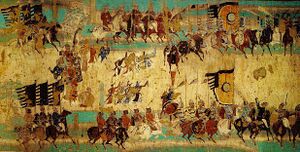
Altough numerically inferior, Bi Liao decided to give battle due to the fact the Degei cavalry appeared to have deserted Qu Hou and he expected his elephant squadron and the king's heavy cavalry to give him the decisive edge. Unbeknown to him the Degei had separated on purpose from the main army shortly after entering Ghanim and shadowed them at a distance, and were now rushing to approach his army from the rear. At the onset of the battle Farukh's elephants were sent charging against Qu Hou's center, nearly buckling it until concentrated volleys of fire arrows and rudimentary rockets caused the elephants to panic and turn back just as Bi Liao's infantry was charging, crashing into them and throwing their lines into a panic. Liao now tried frantically to rally his panicking men to face the Daxian charge while Farukh led his elite bodyguard forwards to buy the main force time to reorganize. As Liao's men slowly managed to bring the elephants down while losing ground to Hou's advance, the Degei nomad cavalry arrived at the battle, releasing several volleys that killed and wounded hundreds of men before charging into the rear of Bi Liao. This charge broke the morale of the joint army and sent it into panicked fleeing. Bi Liao was killed by Degei horsemen while trying to escape and his severed head was presented to Qu Hou, while King Farukh was captured and forced to prostrate before Qu Hou. In the aftermath of the battle the kingdom of Ghanim retained its independence but was was forced into becoming a tributary of the Chen dynasty, handing over both the infant Shang pretender, the king's own heir as a hostage and the fertile plains around Lake Doyeon to the Chen. The fate of the child emperor of the Shang is unclear after this, the most common theory being that he was asphixiated by eunuchs with a pillow on his way back to the Chen court.
The Four Great Impostors
Following the great victory at Horoz and with its western flank now secured, the Chen dysnasty appeared to be finally solidifying its position and for the next fifteen years would turn inwards in what is known as the Short Spring Awakening. A widespread purge of corrupt officials led to improved governance in the provinces and increases in collected revenues for the central treasury. Building of a new palace and tomb complex for the dynasty in the Mengguan hills began in this period. Shang remnants however were not completely erradicated at Horoz and several grandees continued to hold out in the countryside throughout the Short Spring Awakening. In 877 the first of the great impostors arose in the western province of Kuchil; claiming to be Emperor Cao Fu returning to claim his inheritance. An army of Shang loyalists, disgruntled officials and bandits soon coalesced around him and defeated an army led by Kuchil's governor sent to stop him. By 879 another Chen army had been defeated, the king of Ghanim sensing an opportunity to shake off Chen vassalage began to support the false Cao Fu with money and supplies. As he marched on Daguo, the false emperor died poisoned possibly by a member of his inner circle aiming to secure a pardon by the government. Although his army attempted to maintain its cohesion, its lack of a figurehead saw many desertions before being ambushed and defeated in the outskirts of the capital.
The second of these pretenders, Tengu Peg Leg, first rose in the city of Heng in 896. Claiming descent from the last Shang emperor, he and his supporters took over the city administration by force and gained the support of its citizens by abolishing taxes for three years and promising to give every citizen five slaves from towns he conquered. Other cities in the region expelled their imperial garrisons and approached Tengu for protection and relief from imperial taxation . With these defections the territory controlled by Tengu's loyalists grew to cover all of the Daxian northwest. He declared himsef emperor with Heng as his capital and styled his domain as Northern Shang. The loss of important economic centers like Heng and control of important trade routes to the north represented a heavy blow to the Chen dynasty's finances and hobbled its capacity to respond quickly.
Alarmed by the rapid rise of Tengu and the gathering defection of the northwest provinces to him, in 905; after almost five years of revolt, the weakening Chen dynasty appointed a certain nobleman named Da Beipan, who would later found the Zhong dynasty, to the post of Titanic Captain of the West to deal with the rebellion. Da Baipan mustered and trained his imperial forces of roughly 130,000 men for six months before moving his army straight into Tengu's territory. Da Baipan proceeded to invest the walled city of Sho Heng, attempting to storm the city twice but being repulsed. Settling on starving the city out, he was confident that Tengu's army was smaller than his own and would not approach to give him battle. This would prove to be a mistaken assumption as Tengu's 200,000 strong army force marched its way towards Heng barely two months into the siege. Despondent at being so outnumbered and with the possibility of being pinned against the city walls, Da Baipan abandoned the siege and began making his way back to Zhong territory.

Overtaken at the Catun Fields, the vanguard of Tengu's army clashed with the imperial force, badly mauling it in a pitched battle and sending it running from the field. Baipan's army was now at the mercy of his foe. The defeat of Genera Da Baipan by the forces of Northern Shang at the Catun fields left him in a precarious political position at the Chen court. Knowing that his enemies would be calling for his execution, he made the fateful decision to arrange for a truce with Northern Shang and turn his army around in revolt against the Chen dynasty. Proclaiming the Zhong dynasty, he marched his way back to the east and began a 10-year campaign to deprive the Chen of support and cut off the capital. For this revolt, Da Baipan is called the Third Great Impostor. The Chen began forming an army composed mostly of recruits and horsemen from among the northern Degei commanderies under the command of the eunuch Wu Zhao, an experienced battle commander. Paranoia over employing native Daxian units who might defect kept them from calling other forces at their disposal, preferring to keep them as armies in place that the Zhong might have to maneuver around. In any case most of these forces defected or dispersed when the Zhong entered their areas of responsibility, seeing the Chen as a rotting carcass who could rule no more. In 916 Wu Zhao's army first clashed with Zhong forces at Mouyi, routing Chao Mung, one of Da Beipan's lieutenants and capturing three thousand men. Chao Mung managed to rally the remains of his forces and slowly retreated towards the town of Chukun, setting up ambuscades and initiating only small scale harassing attacks against Wu Zhao's columns. Mounting losses and increasing success from Wu Zhao's forces in detecting ambush spots forced Mung to dash for the safety of Chukun's walls which opened its doors to the rebels. Wu Zhao ordered that the river Tobain be redirected to to wash over the town, a feat achieved under constant arrow fire and attempts to stop it by Chao Mung's forces. The diversion of the river's flow destroyed the town of Chukun, drowning the inhabitants, the rebel soldiers and Chao Mung himself. For this military feat Wu Zhao was given the title of 'River Charmer' for he had charmed the river to do his will as a snake charmer does with snakes. The defeat altough a heavy one was not fatal for Zhong forces who were raising more armies among the peasants of the central provinces.
Defeating an army led by Duke Kimm sent to check his advance near the town of Sashun. The battle was significant in that Kimm's army was the last significant force the Chen could field that could be used to protect the capital, as other forces were too far away or were abstaining from the fight, waiting to throw their support for whoever was victorious at the capital. Kimm was executed by the rebels but his defeated army agreed to join with Da Baipan. The Chen court attempted to negotiate with their rebellious general and Baipan agreed in what is generally accepted to have been a ruse for time. His true aim seems to have been gaining time while he negotiated in secret with sympathetic nobles on surrendering the capital. By the summer of 910, Zhong forces were only ten kilometers from the capital, holding an incontestable superiority in men, supplies and access to siege equipment compared to the defenders of the capital. A cabal of nobles rode out to meet with Da Baipan and placed before him the head of Emperor Waguo of Chen, surrendering the city and signifying the death of the Chen dynasty. Zhong forces marched into Daguo to great fanfare with Da Baipan taking the regnal name of Emperor Gong.
Zhong Dynasty (915-1550)
Revolt of the Degei Confederation

Having unseated the Chen dynasty by treachery and with the stain of defeat on the battlefield against Northern Shang, Emperor Gong of Zhong wanted nothing more than to raise new armies to reclaim what he saw as imperial territory in revolt. However the destruction caused by his own insurrection, the pressure on a depleted treasury to pay the wages and bonuses of his standing army and a restless population that were tired of war and high taxes were insurmountable obstacles to realizing his ambition of fully reunifying the empire in the short term. By 918 the northern nomad commanderies were close to revolt, with pro-Daxian nobles and officials being forced to flee their lands by a certain Darukh Khan agitating to reunify the tribes under his command. Darukh Khan was the son of a local Degei chief and functionary and had served in a Chen cavalry unit. Angered by the reduction of imperial stipends going to him personally and other local chiefs, and the resulting disruption of local patronage, Darukh Khan renounced his Daxian titles and began arresting Zhong tax collectors.
Darukh Khan proved to be a charismatic orator for he was able to convince thirteen other clan chiefs to follow suit and mount an attack on the garrison town of Baliq where they killed the town guards, shaved the moustache of the local magistrate before kicking him out of town and forced the townspeople to prostrate themselves before Darukh. Darukh proclaimed himself Great Khan of the Degei and Emperor of the Ching dynasty, with both titles implying universality of his rule, Daxian historians name him as the Fourth Great Impostor of the period for his ambition was to rule not just his fellow nomads but to advance south into the empire. In his desire not to be seen merely as a savage invader and out of his own personal sensibilities, Darukh Khan retained many aspects of Daxian customs and political culture. The Daxian language continued as the language of government in his territories, while the Degei dialect was mostly used in the army. He opened his own school to train bureaucrats for government, modeled on the Daxian service schools. Baliq was turned into his capital and in time he built extensive infrastructure, a palatial complex and stone brick walls; something unheard of in Degei settlements. In doing all this it is clear he did not want to destroy the empire, but initially emulate it and late fully seize it and use its resources for his own ends. Darukh Khan organized a massive raid against Naxia in modern day central Tanhai in the spring of 919, pillaging many settlements and making an abortive attempt at capturing the fortress of Gopteng. Emperor Gong's Naxia governor, a nobleman by the name of Kai Kiu organized a robust response, chasing the Degei's raiding parties out of Naxia and back into Darukh's defacto territory. Wary of an ambush and knowledgeable of nomad fighting tactics, Kai Kiu wisely did not pursue his enemies into the grasslands and marched back to Naxia. The Degei had been chased off but had acquired significant amounts of looted goods and coin in addition to valuable intelligence on the military dispositions and capabilities of Zhong forces in the area. Darukh Khan would wait until the spring of 920 to make another move. The Degei did not spend the rest of 919 in idleness however, sending envoys to the United Cities to reach agreement on the formation of an anti-Zhong alliance. The document recording the treaty has been lost to time but Zhong documents of the time record the expiration of the ten year truce once agreed between Emperor Gong and Tengu Peg-Leg, once ruler of the United Cities. So while the specifics of the alliance are unknown, that they collaborated from 920 and onwards is a widely accepted fact.
In 920 a large army personally led by Darukh Khan descended on the Naxia commandery once more and this time the governor's outnumbered forces were comprehensively destroyed at the Battle of Hashu, with Kai Kiu barely escaping with his life. An official account from the time states the governor and his surviving retinue rode south without stopping for three days and nights to warn the closest imperial garrison at Kuchig. Back in Naxia, Darukh Khan issued a proclamation where he claimed to be fighting for the restoration of the Chen dynasty, denounced the Zhong as illegitimate usurpers and invited all servants of the state to switch their allegiance. This was a clear threat to the position of the budding Zhong dynasty even if the proclamation was issued by a 'foreign' ruler of nomadic stock, many officials did indeed switch sides. To compound the Zhong's dire situation, the United Cities honored their agreement with the Degei and sent ten thousand of its Iron Legion under Warmaster Shing to support Darukh Khan's invasion. Crucially the Iron Legion brought with them siege weaponry and had the expertise to employ it efficiently, a crucial military necessity the Degei lacked and one that would be key in any advance further south. Darukh's total forces during the campaign are thought to never have exceeded 100,000 between his own tribesmen, United Cities allies and Zhong defectors.

The Zhong for their part had the emperor's own battle tested personal army of around forty five thousand men, at least three provincial armies of uncertain loyalties and fifteen thousand levies sent by the Lakdu and Ghanim tributaries. Rather than meet the invasion head on, the Zhong adopted a strategy of playing for time by fortifying strongpoints, avoiding large scale battles against its more mobile foes and employing diplomatic overtures and bribery to try to degrade Darukh Khan's coalition. Darukh Khan resumed his campaign with a two pronged attack , Darukh himself laying siege to the walled city Taizhou and sending half of his force under his brother Orgai to bypass the city and continue moving south to stop any relief force that might be sent. The siege lasted for seven months and saw some of the first use of military sappers to undermine the city walls, with the Zhong using rudimentary rockets against the Iron Legion siege towers. The Zhong defense was tenacious and they carried out multiple sallies, with one night raid reaching dangerously close to the Khan's royal pavillion. However with no relief coming, by the winter of 920 the walls of Taizhou were finally breached and after a few hours of resistance in the streets the remains of the garrison surrendered. The city was sacked and the remaining Zhong soldiers conscripted into the invading army. Orgai for his part continued riding south, engaged and defeated a blocking force near Pianqu, the city surrendering without a fight.
Orgai's march south was met with little organized resistance and many cities simply expelled their imperial garrisons and opened their gates to him, so as to avoid the terror of a siege or sack. Meanwhile Zhong spies had made contact with the Grand Company of the Virtuous Worms who were serving as mercenaries and handled the rear and scouting for Orgai's army. In secret communications with Kai Kiu, they were bribed into switching sides and setting up a trap for Orgai. The scouts led the army into the Krong Pass were Kai Kiu's army was waiting in ambush. Trapped in from both sides by the sudden betrayal of his mercenaries, Orgai's army was cut down from all sides. Orgai himself tried to charge through the traitors but his panicked horse was killed by arrowfire and crushed its rider. Only a few dozen riders survived the battle to inform Darukh Khan of his brothers defeat. The defeat forced Darukh Khan to begin force recruiting more locals from cities he had conquered whereas before he had avoided this, seeing non Degei as poor warriors and unreliable. The United Cities sent another seven thousand men to reinforce him and Warmaster Shing. Meanwhile Darukh sent back word(through letters that are now housed in the National Museum of History) north to his cousin Erzen, who was one of his chief counselors and ruled the Degei heartlands while he was away, to gather more horsemen and send them south to his aid. All in all Darukh expected to gather some thirty thousand extra men in reinforcements. Unbeknownst to him, Zhong envoys had approached Erzen and presented him with Orgai's embalmed head, cautioning Erzen that his cousin's rebellion had its days numbered. At the same time they promised him rich rewards and titles if he witheld any more support for Darukh, which he agreed to do. Now cut off from his northern supply lines, Darukh Khan was forced to rely solely on local supplies and whatever the increasingly dubious United Cities were willing to give.
Wars against the United Cities
Main Article: United Cities
Conquest of Ghanim
Vassalization of Canpei
The Great Tumults and fall of the Zhong
Qian Dynasty (1550-1946)
Exploration of Australis and colonization of Stenza
Stenza colonized in 1742, lost to revolution in 1921
Economic and Military Modernization
Usage of colonial profits and resources to fuel mass industrialization and the building of the 'Great Armament', a large and modern army and navy.
Second Great War
Daxian involvement starting in 1936 invading island of Ayermer, leading nation of anti-Burgundie league in Alshar. Siege of Ayermer
Glorious Revolt and military rule

The Daxian involvement ended amid acrimony and disagreement between the army and the monarchy, many objectives had not been met for the cost that was paid. The army was under the control of two strongmen, Dai Hanjian and Qiu Heng. Both ended the war as full generals and popular ones at that, they were the main planners and executors of the offensives in west Audonia, the Austro-Caldera operation and the reclaiming of Ayermer. Qiu Heng was made chief of staff of the land forces one year after the end of hostilities, both to to install someone seen as a monarchist and to restore the confidence of the army in the leadership. Both him and his colleague Dai Hanjian believed the home front had been badly neglected by the imperial government and the drug addled emperor Hongli. They especially disliked the growing popularity of democratic and socialist movements and their demands for a liberalization of the political system. To many in the military, the imperial system and bureaucracy had stopped being a guarantee of stability and transformed into a liability that stood in the way of dealing with internal agitators. The two officers created a secret society named the Lodge of the Righteous Serpents to gather like minded officers and overthrow the Imperial system and replace it with a military dictatorship. On December 16th 1946 tank columns aligned with the lodge entered the capital from all sides while squads of soldiers went took over ministries. Other groups went to the houses of ministers to arrest them, the minister of defense was shot and killed after he tried to resist his captors. Qiu Heng himself led the takeover of the imperial palace and the capture of Hongli, forcing the imperial guards to surrender under the threat the emperor and his family would be executed once the palace was inevitably taken. The coup was carried out in two hours and resulted in minimal casualties on both sides, stemming from the element of complete surprise achieved by the putschists and unwillingness on the part of many soldiers to defend the failing monarchy. An ecstatic Dai Hanjian took to the airwaves and announced the Glorious Revolt had succeeded and the era of dynastic rule had come to a definitive end; he declared the formation of the Committee of National Restoration that would lead the country with himself as its head and Qiu Heng as his deputy.
The junta moved quickly to assert its authority and shore up popular support; a line up of technocratic ministers were appointed to replace the old dynasty loyal bureaucrats and the Emperor was made to officially abdicate the throne and renounced the Heavenly Mandate before being put under house arrest until 1948 when he died of complications of diabetes; his teenage son and heir died soon after in unclear circumstances. Hongli's royal consort, Princess Keuto of Metzetta was allowed to depart back to her homeland with two of the emperor's daughters. Many other members of the former imperial family were either put in prison, work camps or sent into exile to Metzetta. A referendum was organized asking the population if it agreed with the junta's capture of power and despite reported instances of pressuring people into voting, threats of violence and transporting people from rural areas on military buses to voting booths the result was overwhelmingly positive with an approval of 86%. This period is where the political qualities of Qiu Heng first began to rise to the surface, while Dai Hanjian was the public leader and face of the junta and was fairly charismatic, Heng was the real operator behind the scenes. Ambitious officers soon began to be sidelined from the ranks of the junta, some were arrested after being accused of plotting a countercoup or of missappropiating army supplies; by 1948 out of ten military zones, eight were commanded by people considered to be part of Qiu Heng's political clique.
If Dai had any misgivings about the growing influence of his friend he gave no indication in public or private conversation that survives; he gave the post of Minister of Defense to Qiu in 1949 and allowed him to staff its structure as he saw fit. Shortly after Qiu began speaking of setting up a political structure to gain more legitimacy in the eyes of influential Western nations, whose financial help might be needed to continue army expansion. The junta leader seemingly disagreed with these notions and intimated that he would get the job done and if necessary would stay on the job for twenty years. The insinuation of quasi imperial ruling for life was not lost on Qiu Heng who may have begun quiet preparations to oust Dai, or perhaps have him assasinated. According to medical records Dai Hanjian fell gravely ill from a bladder infection of worrisome intensity. Despite all attempts to save his life, the junta leader died on December 12 1951 at the age of 56. Authors critical of Qiu Heng suggest he had Dai poisoned with arsenic to get him out of the way of political reforms and stop his succession plan which may not have included Qiu in it anymore; no conclusive evidence has ever been found to corroborate this accusation. As deputy leader of the Committee of National Restoration, Qiu was sworn in two days later as leader of the junta and the country.
Republican Period (1946-1992)

Qiu Heng's rise to the leadership of the country saw for the first time the ascendance of politics over purely military leadership; Qiu Heng saw the perpetuation of the military junta system as inherently unstable, absent an electoral mandate and the legitimacy it could bring, any ambitious general in charge of a military zone could feel themselves justified in attempting to take power the same way as the junta did in the first place. Since Qiu distrusted the established but outlawed old political parties and their cadres, he decided instead on building a new party from the ground up without 'any of the old chaff'. As the base of his new party of state he chose a pro-military civic association called the National Daxian Rally or NDR that had existed since 1945 but had never reached much relevance. The NDR had been started at the behest of military intelligence and was originally led by people close to it. Qiu directed the Ministry of Social Services and the Ministry of Finance to direct significant financial resources to the NDR to support its growth into a real national party that could hold on to power. The junta leader himself joined the NDR in the summer of 1952 and was elected its leader 'by acclamation' of the party delegates. This was followed by a massive bump in party membership as government employees joined en masse(to curry favor, preserve their jobs or genuine agreement) and trade unions and government contractors enjoined their affiliates and employees to do the same. In this early stage the biggest labor union of the country, the then All-Daxian Workers Central Union negotiated generous terms on collective bargaining and perks for its members in exchange for its unrestricted support for the new political machinery. Qiu Heng announced the first national elections for President and a new National Assembly would take place concurrently in mid 1952, he also announced his candidacy at the head of the now renamed National Reconstruction Front or NRF. To contest in these elections, Qiu's junta released the leaders of the Daxian Liberal Party, while of the more popular communist cadres only a handful were released. The campaigning was anything but fair, opposition events were routinely cancelled or when they went ahead they were not televised or were broken up by thugs. Several campaign aides of the communist party were assassinated and offices of the Liberal Party attacked by mobs (historians agree the mobs were paid by the government). The NRF campaigned mainly on a platform of nationalist xenophobia; its political rivals were painted as inwardly thinking like Bergendii wearing Daxian faces, lovers of all things foreign and traitorous internationalists willing to sacrifice the Daxian people in exchange for utopias being created abroad. On economics the party swung hard towards economic protectionism with policies such as the creation of nationally owned companies on strategic sectors like oil to massively employ people.
Despite the clearly tilted electoral campaign, Qiu Heng enjoyed geniune popularity with the population for his wartime achievements, his role in overthrowing an unpopular monarchy and his penchant for curbing and publicly punishing the excesses of other military officials. In one such instance he demoted a general to the rank of private for proposing that farmers protesting against the building of a railroad through their lands should simply be mowed down with machine guns; the dressing down and demotion was televised. Despite his reserved personality, he actively promoted his public persona as the 'People's General' with working tours of the countryside, visits to factories, children's nurseries and schools; polls of the time giving him a seventy percent preference of the vote may have been skewed but their trajectory was nonetheless true, his advantage over his rivals was an insurmountable chasm. The May 1952 polls resulted in an overwhelming victory for him; the NRF and Qiu Heng won with 73% of the vote, the Liberals won 13%, the Communists won 9% and the Peasant and Farmers Party won 5%. The NRF and the army could comfortably rule alone and had pushed the opposition to the margins of political representation, the Peasant and Farmers Party soon after decided to merge with the NRF arguing their objectives were better served as part of the governing party. The 1952 election was a watershed in the politics of Daxia, it marked the beginning of an almost uninterrupted thirty four year period of rule for the NRF, its percentage in national elections would not dip under eighty percent until 1984 when Yang Qiu secured 'merely' sixty nine percent of the vote during his reelection campaign.
Birth of Daxian corporatism
Great Crusade of Uplifting
Factional infighting and the Slow Death
One Party Period (1992-present)
Rise of the Party of Daxian Democrats
Liquidation of the Left
See also: Lushan Square Massacre
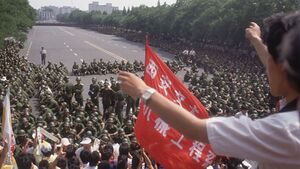
By mid-1993 the Bureau of State Protection had been given the directive to begin the repression of the Communist Party of Daxia (CPC) and its armed wing, the Army of Common Men (ACM). Operation Dendron decapitated the communist political leadership and left the party directionless however the cell structure of the ACM prevented most of its leaders from being found out and killed. This operation also had the secondary effect of rendering the CPC and the political path almost irrelevant in the conflict to come. Dendron marked the beginning of a bloody period of state terrorism as the government sought to crush the armed resistance of the ACM by any means necessary. Hundreds of thousands of left-wing activists, students, journalists, writers and anyone suspected of sympathizing with the political left were imprisoned, tortured and killed. The ACM responded by unleashing a wave of terrorist bombings, hit and run attacks on military and police targets and killing of government employees as reprisals. Increasing efficiency in intel gathering on the ACM resulted in the design and implementation of Operation Eschaton, which succeeded in killing hundreds of leadership figures all across the country. Finding itself increasingly cornered in urban areas by the security organs, the bulk of the ACM moved into the countryside whilst leaving only smaller three-man cells in the cities. In rural areas the organization had a degree of grassroots support, especially in the poorer west part of the country. PCD initiated security reforms had not yet reached these locales and the local security forces were too weak to suppress the ACM on their own. While the ACM had appeared to be on the backfoot or even the edge of defeat at the end of 1995, its move to the countryside allowed it breathing room to reconstitute itself and Operation Eschaton had not yet taken an irreversible toll. It coerced peasants to join its force in increasing numbers and began expanding an area of actual territorial control that surrounded several provincial cities. By the summer of 1996 the ACM had recovered in numbers and stormed the city of Khov, defeating the local garrison and with the local police force fleeing without a fight. The ACM declared a Khov Socialist Republic and invited the 'revolutionary' sectors of the city to join its forces.
The government responded by initiating a special combined operation by Army and BSP battalions to clear the city and the surrounding area. Power and water were shut off to the city, roads blockaded and supplies turned back while a massive artillery bombardment began. ACM forces attempted to repeatedly break the siege by using truck bombs and exploiting the temporary gaps created but air power turned them back everytime. After two months of sluggish advance amid heavy fighting, the government was in position to assault Khov and did so starting in September 1996. Of note in the Battle of Khov is the participation of a new entity called the Peace Brigade, which had links but was not subordinated to the BSP. It is rumored however that the Peace Brigade was the brainchild of Prib Dodd, head of BSP at the time. Three more weeks of fierce urban fighting ensured that most of Khov was destroyed and the brutality of the Peace Brigade made sure most of the population followed their city into oblivion. Only three members of the ACM's Directorate survived the battle and fled the fall of the city using tunnels dug under the city, escaping further west.
After the decimation of the ACM at Khov and the end of their territorial experiment, the vacant Directorate seats were slowly filled by BSP infiltrators acting upon Operation Maniphage. If the ACM's leader was not a government agent by this point, he was certainly surrounded by them. The new Directorate blamed the conservative leanings of the peasantry and their lack of revolutionary zeal as the root causes for the defeat and moved to suppress them. During 1997 the ACM razed close to a hundred villages, stealing crops and cattle, massacring the inhabitants and conscripting the children into its forces. Crafted by the architects of Operation Maniphage, these attacks caused a decisive break between the ACM and the western countryside. This also led to schisms to break out in the ACM, with at least two members of the Directorate(non government assets) leaving the organization and branding it insane and terroristic. With insider information of the organization's movements, the BSP hunted down its remaining cells in quick succession during 1997 and early 1998. Chancellor Linge Chen declared the organization defeated in a speech to the People's Assembly on May 1st 1998.
Suppression of the Right
The persecution of the leftists was widely applauded and supported by the business class, especially the plutocrats that had benefitted by the cronyism of the military government that preceded the PCD. They mistook the government's savage attack on socialism as a sign that it intended to loosen even more its grip on the economy, perhaps by handing over control of strategic sectors to private capital. This mistaken conception would cost them dearly as the organs of terror began working again and the totalitarian nature of PCD thinking revealed iself in full. The BSP's systems of mass surveillance under Operation Panoptes had been in full swing since 1992 and the wealthy were not exempt. In March 1999 around fifty of Daxia's wealthiest businessmen were arrested and taken to Building 82, their personal bank accounts and those of their companies already frozen. With notaries present and under threat of torture or death they were forced to sign their assets away into the hands of the government. In a single move the Party acquired control of 25% of the nation's economic assets including industrial complexes, banks, mines, agricultural lands, hotels, commercial fisheries and much more.
The House of Troubles
The Xingfu Dejia or House of the Blessed Brothers was a self help cult that had been growing in the country since at least 1985. The weakened NRH government tried to supress it at first but eventually gave up and allowed it to operate freely, perhaps hoping to complicate things for opposition groups if they took power. After the accession of the PCD-led government, things changed for the movement and it began to be more closely scrutinized for signs of subversive activities. Harassment by authorities contributed to the radicalization of the groups founder, Min Yaaj Zoov who became more dictatorial and began indoctrinating his followers towards violent action.
Stabilizing development period
Post Linge Chen intra-Party struggles
Invasions of Crona
- Invasion of Ixa'Taka and Nanzitolclatl
- Frozen conflict with Alpachnee confederation
- Varshan War
Geography and Ecology
Climate
Daxia experiences a combination of humid continental, humid subtropical and tropical wet climates as defined by the Kroger climate classification scheme. Tropical wet conditions are found closer to the equator and along the western and south coasts, with regular rainfall and constant warm temperatures of up to 27 degrees. These areas regularly receive around 150 inches of rain per year. Central Daxia has predominantly humid subtropical climate conditions. In the Daxian interior, summers are typically longer, hot and humid. Monthly mean summer temperatures are normally between 24 and 27°C. A deep current of tropical air dominates the humid subtropics at the time of high sun, and daily intense but brief thundershowers are common. Summer high temperatures are typically in the high 20s to mid-30s °C, while overnight lows in the summer are typically in the lower 20s °C. Monthly mean temperatures in winter are often mild, typically averaging 7.5 to 16°C . Daytime highs in winter normally are in the 10 to 16°C range, while overnight lows are from 2 to 7°C. Rainfall often shows a summer peak while other areas have a more uniform or varying rainfall cycles, but consistently lack any predictably dry summer months. The areas around lake Doyeon are closer to the humid continental climate, with winters were temperature can drop below 0°C and even snow in some higher altitude areas and dry summers with around 40 mm of water precipitation. Snow may be more common than rain in these areas of the country.
Geography
-
Northern steppe region at Ulug.
-
Lake Doyeon high up in the Arik Mountains.
-
Forested meadow in the Mirzak countryside.
Daxia is bound to the south by the Taizi sea and to the west by the Ocean of Cathay. Geographically Daxia possesses two notable geographic features. The Arik mountain range which covers most of western Daxia that has served as an important geographic barrier against invasion by other powers to the west. Nestled among this mountain range is Lake Doyeon, the nation's largest lake with tributary rivers that is a vital source of fresh water and gives way to fertile coastal plains on which much of Daxian agriculture and population centers are based. The other feature is the Jintao plateau that dominates central Daxia and where several important rivers are born. The coastal areas and the Northwest are mostly flat plains, very amenable to mass human habitation.
Ecology
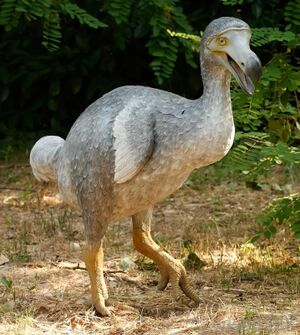
Daxia has a vibrant array of animal and plant life within its borders both natural and transplanted by less than careful travelers. It is home to the largest predator in Alshar, the hyena-like Long-toothed Hound or Zhangya. Also endemic is the 'Daxian chicken' or Giswi which has been domesticated and turned into an inexhaustible source of food. Some of the outlying islands have specimens reminiscent of past eras of the world such as giant flightless birds such as the Danonino, which have survived due to the extreme isolation of their habitats. Daxia's rivers are the point of origination of the infamous green crab (Carcinus Cocytus) invasive species. While C. cocytus is believed to be a river crab, it spread from inland Daxian rivers to the Ocean of Cathay and from there to Crona, Audonia and as far as Australis. This species of crab devastates local populations of sea slugs and mollusks and reproduces very rapidly. Daxians eat it in soup or fried on a stick.
However Daxian industrial policies and disregard for pollution have meant that the habitats of several species have slowly disappeared or been seriosuly curtailed by human encroachment. According to the Alshar Environmental Integrity watchdog, around fifty species of insect, small reptiles and birds went extinct in Daxia in 2025 alone. Conservation efforts and replanting schemes have been deemed to be totally insufficient and chronically underfunded for decades.
Another facet of Daxian government's involvement with the ecology is a scientific program to genetically engineer and breed back animals that only existed hundreds of thousands of years ago, known as Megafauna. Work on the breeding of the creature known to scientists as Paraceratherium is well underway and several dozens specimens could be released into the wild within the next two decades. Enviromentalists have quietly criticized the Megafauna project as a monumental waste of resources that could be used to save modern animal species and as a maniac's idea of playing god.
Government & Politics
Main Article: Government of Daxia
Government
According to the Constitution of Daxia, the country is a federal republic, wherein the Chancellor is both head of state and head of government. The Republic of Daxia is fundamentally structured as a multi-party representative democracy. The government of Daxia follows the conventional republican structure with three branches that in theory function independently of each other and serve to maintain a balance of power in the system. The constitution of 1993 created by the a legislature dominated by the PCD however tinkered with the system and did away with any pretense of balance, first by abolishing the post of President and replacing it with a Chancellor with much beefed up powers, with critics complaining that its outsized powers are more fit to an Emperor than to the head of a democratic system. The second change was the abolishment of the Senate with the remaining body being renamed to the People's Assembly and enlarged to five hundred members, still elected by direct vote but carefully vetted by the Bureau of State Protection. The Judiciary saw a quick erosion of its independence, with the Supreme Court expanded from seven to eleven members(all new members with clear sympathies for the PCD). The organ in charge of the designation of lower level judges and magistrates was folded into the control of the Ministry of Interior. These and other constitutional changes guarantee the absolute primacy of the executive branch, with the legislative and judicial as subservient junior partners and rubber stamps.
- Executive: The Chancellor is the Supreme Commander-in-Chief of the Armed Forces, can veto legislative bills before they become law, and appoints the cabinet and other officers, who administer and enforce federal laws and policies.
- Legislative: The unicameral Assembly of the People, made up of the 500-members, adopts federal law, declares war and approves treaties. The Party of Daxian Democrats has maintained an absolute majority since 1992.
- Judiciary: The Supreme Court and lower federal courts, whose judges interpret laws and can overturn laws they deem unconstitutional.
The Chancellor is elected by popular vote for a six-year term. There are no term limits in place.
The Party
Main Article: Party of Daxian Democrats
Since 1992 Daxia has been functionally if not constitutionally a one party state, with the PCD in control of all the governing apparatus at a federal, state and municipal levels. The Party positions itself as the guarantor of the national ideology of Zhangwo and the special destiny of the Daxian nation on the world stage. Party membership is central to all adult citizens who wish to engage in politics and governance. Likewise advancement in the private fields is also heavily influenced by adherence to political orthodoxy. Foreign notions of democracy and personal freedom are considered to be anti-national in nature and against the Zhangwo ideology and Daxian advancement. The rise to power of the Party is considered in internal documents as the end of political history, and no further political evolution is to ever take place. In this context the Party considers any attempted political expressions or discourse outside of its margins to be illegitimate and will act accordingly to stamp them out.
Under the leadership of First Secretary Prib Dodd, a measure of internal democracy has returned to the Party, with a system of election primaries determining who will be appointed to important leadership positions such as provincial governorships or mayors of important cities.
Judiciary
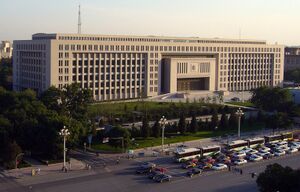
Main Article: Judiciary of Daxia
The Judiciary of Daxia is responsible for the administration of justice including prosecutions, civil and criminal disputes. As per the Daxian Basic Law it is nominally independent of the executive and legislative branches but in practice it is run by the Ministry of Justice with input from the Party's Legal Affairs Commission. The Daxian judiciary branch is formed by three basic levels, the lowest being the District Magistracies, the next level being the province High Magistracies and the highest tier being the nation's Supreme Magistracy composed of seven magistrates. Province High Magistracies serve as appelate courts for district Magistracies and the Supreme Magistracy does the same for province High Magistracies. The armed forces maintain their own separate court system and its members can only be tried by civil courts if discharged from service.
According to the current Basic Law, the seven members of the Supreme Magistracy are nominated by a committee composed by legislators, judges and other civil officials and ratified by the Chancellor. One magistrate acts as the President of the court, and another acts as the Vice President. After being appointed the Supreme Magistrates serve for a period of twelve years.
Law Enforcement
See also: Bureau of State Protection
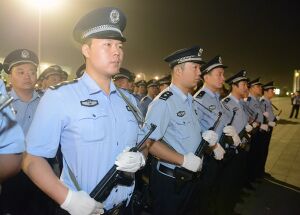
All uniformed police operate under the authority of the Commission of Public Safety (CPS), itself an arm of the Ministry of Justice. The CPS is in charge of normal, day-to-day law enforcement including but not limited to preventing, detecting and stopping illegal crimes and violent behaviour, handling mass incidents such as assemblies, demonstrations and maintaining order in public places, managing special industries and dangerous goods, and handling public security administrative law enforcement cases. While CPS is organizationally independent of the Bureau of State Protection, it can be operationally placed under the latter's command under certain situations. CPS is the most commonly used tool of repression by the government to suppress potential trouble and it is greatly feared by the public.
Less visible but with more built-in authority is the Bureau of State Protection (BSP), the political police of the state. This agency is responsible for internal security, foreign intelligence, counter-intelligence, border security and other tasks conductive to protecting the state and preserving the power of the Party. The BSP is responsible for most atrocities committed by the Daxian state including political purges, mass imprisonment or extermination of troublesome groups and other forms of state terrorism.
Military
Main Article: Daxian Armed Forces
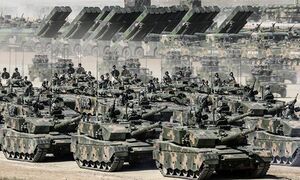
The Daxian Armed Forces are the national military of the Democratic Republic of Daxia. Steeped in the traditions of the armies of the Imperial and Republican periods, the Daxian Armed Forces are highly professional and represent the largest and most well equipped military force on the continent. The military is divided into the Daxian Land Forces, the Daxian Air Fleet, the Daxian War Fleet and the Special Purpose Force. Almost five percent of the national GDP is devoted to fulfilling the budgetary needs of the armed forces.
There is close to three million active duty personnel between all four branches of the military. Conscription is mandatory by law starting at age 16 for all citizens, recruits must perform 24 months of military service and are placed in the reserves for 30 years afterward. Women are also obligated to perform military service but as of 2028, they are not allowed on ground combat roles. The government has long pushed for the development of a military industrial complex that can help the armed forces achieve self sufficiency in the production of armaments, vehicles, warships and other military technology and platforms. In recent years the Daxian Armed Forces have been deployed and seen action in multiple military conflicts in Crona and even more recently they are engaged in an occupation of parts of Varshan.
Foreign Relations
Main Article: Foreign relations of Daxia

The foundation of the nation's foreign policy is based on the principle of non-interference in the affairs of other nations, a principle that has been enshrined in the Basic Law since 1953. The Daxian state maintains diplomatic relations and keeps embassies with almost every nation in the world and this is the case in all but the most extreme or risky scenarios. The unique nature of Daxian practices and national outlook has at times caused suspicion and resentment in the 'Western World'; nonetheless Daxia maintains excellent relations with many countries, often of a transactional, non ideological nature and always pursuing the win-win model of interaction. Daxia has always been and remains a strong supporter of international diplomacy and the League of Nations as a means to address and solve issues between nation states. However Daxia is willing and able to use military force to protect its vital interests and citizens as a last resort as evidenced by its participation in the Final War of the Deluge.
Daxia is a member of the East Alshar Confederacy, a multinational initiative to promote economic development and give diplomatic, political and military support to the nations of eastern Alshar. The first summit of the EAC took place in Ankae, Metzetta in 2028.
Demographics
The 2027 national population census of Daxia determined the total population to be 744,900,597 with a net population growth of around 0.6% per year. Population growth has slowed down from around 1% in the last two decades due to concerns about overcrowding and deleterious effects on social services. Emmigration restrictions and limitations post 1992 contribute to minimal population outflows, other than to a few authorized destinations. Non Daxian ethnicities have significantly higher birth rates leading to forming majorities of the population in certain localities.
Ethnicity
The ethnic makeup of Daxia has been relatively stable through history, with a mostly homogenous ethnic Daxian majority that has persisted into modern times, sometimes maintained by sudden ocurrences of genocidal pogroms. Nomadic groups and polities from the north and northwest that historically existed and settled in the borderlands such as the Degei and Duoman peoples were gradually incorporated and some of their customs and fragmentary portions of their languages appropiated by the Daxian. Even today names found in Degei oral traditions are very popular in the northwestern provinces.
The conquests of the Oduniyyad brought new groups of completely distinct peoples to the western borders of Daxia, from dusky brown Umardis to charcoal skinned Audonians, these new arrivals left their influence in the farthest peripheries through holy wars, trade and slavery. This gave rise to a local syncretism and intermingling between Audonian and Daxian cultures and languages that continues to this day, especially in the form of the Yue ethnic group that resides mostly in neighboring Rusana, which is believed to be an admixture of Daxian and Arab peoples. In the modern era, western Daxia continues to be the most diverse part of the country albeit not without the existence of simmering ethnic tensions only kept at bay by heavy handed government control.
Since Daxian involvement in the Deluge, hundreds of thousands of people of northern Cronan stock have fallen under the rule of the Republic and have found their way to the mainland as low skilled workers or servants. Rarely speaking the Daxian language and without official status as citizens, these Cronans have begun forming an underclass in various cities, often clustering in sprawling shanty towns. So far authorities seem to be ignoring the issue of these so called 'transients'.
Language
The language spoken by a majority of Daxia's population is Daxian, which is spoken by approximately 90% of the population. Under central government directives and successive regimes, regional dialects have been practically wiped out by officially discouraging their use vis a vis standardized Daxian. Through the intentional propagation and prioritization of Daxian, cultural imperialism is manifested. Minority languages and dialects are pushed to the fringes, with reduced visibility and opportunities for growth and development. The imposition of Daxian as the dominant language not only limits linguistic and cultural autonomy but also hampers intergenerational transmission of cultural knowledge and traditions. As a result, the rich tapestry of languages and cultures that once flourished within Daxia has become increasingly homogenized, eroding the unique identities and heritage of a once diverse population. Abroad Daxian is not merely a language of cultural preservation or linguistic convenience. It has been strategically employed as a tool of cultural imperialism, exerting influence and dominance over other regional languages and cultures. Such is the case in neighboring Canpei and Tanhai, nations with close cultural and historic links with Daxia but where their own cultural identity is weaker and is actively undermined by Daxia.
Religion
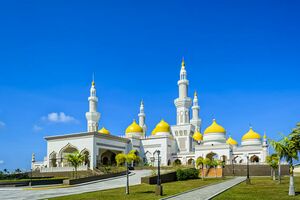
A plurality of Daxian citizens hold no religious views at all, the result of a decades-long campaign by the government to enforce a form of State Atheism. Starting in 1965 under President Chi Long Qua, the campaign was dubbed the Patriotic Initiative against Superstitions and its objective was to eliminate religion identifications that could undermine the power of the state. Churches, mosques and shrines were shuttered, religious leaders arrested or sent into internal exile and all public displays of piety were outlawed. The suppression of religion was later enshrined in the Law of Superstitious Orders in 1971. This law was replaced with the Law of Religious Bodies in 2011 by the government of Linge Chen, which allowed worship in government controlled environments and created the Directorate of Religious Affairs to directly oversee religion.
The Christian faith is represented by the Democratic Christian Church of Daxia and the East, the official body representing catholics in the country and not officially recognized as being in communion with mainstream Catholicism. The Democratic Christian Church of Daxia and the East claims that it is the legitimate continuation of the papacy and its leaders are styled as Popes. Approximately 6% of the population adhere to this church. Islam is another faith of importance, especially in the western provinces which once belonged to Rusana. Between 10% to 13% of the population identify as practicing Muslims, mostly of the Shia school. Both faiths are overseen by the Directorate of Religious Affairs under the Ministry of Interior, the Directorate trains all religious representatives, be it bishops, imams or muezzins. There are also older traditions of ancestor worship particularly among rural Daxian which survived from the Imperial era, based around local shrines. Unlike hierarchical religions, ancestor worship was not persecuted too much and continued on in the background much as before. Permission to reopen the Jade Garden shrine in Mirzak was granted in 2014.
Education
Education in Daxia is under the responsibility of the national government and its Ministry of Education, local and province level governments having very little input on the subject. Illiteracy was basically erradicated in the mid 1990's, according to the Ministry of Education the literacy rate stands at 99.8%. Outside of uniforms and school supplies, all education is free in Daxia. Primary education begins at age six lasts for six years, roughly until the child is age twelve. At this point the educational system branches out into two divergent systems. The fifteen percent lowest ranked students of any class are filtered out into the Technical Training Track (TTT) where further academics are discontinued and instead they receive a six year education on technical skills and factory processes to prepare them for life as blue collar workers, tradesmen and other types of skilled manual labor.
Those students who avoid the technical track can continue their secondary level education along what is termed as the Party Specialist Track. Students in this system have a well rounded education that prepares them for specialized education in the State universities. Anyone aspiring to work in government must necessarily have gone through the Party Specialist track of education. Party membership upon completion of their university courses is not guaranteed for these students, but it is much more likely than for technical training students. The majority of the professional, bureaucrat and entrepreneurial classes are formed in this education track.
Ethnic minorities, children with development and mental deficiencies and foreigners with no status are forced into a separate system called the Low-Grade education track. Low-Grade students are taught only reading, writing, the basics of mathematics and geography, heavily curated classes on the particular group's religion and intensive doses of government propaganda. The Low-Grade track ends at the sixth year and those who complete it are sent to back to their communities to fend for themselves in any profession they can without much official control or tracking.
Teaching methods, notable educational institutes, government propaganda and brainwashing in post-1992 schools
Major cities
Largest cities or towns in Daxia
2025 | |||||||||
|---|---|---|---|---|---|---|---|---|---|
| Rank | Province | Pop. | |||||||
 Mirzak  Daguo |
1 | Mirzak | Central | 20,674,000 |  Menshen  Pianqu | ||||
| 2 | Daguo | Yang | 16,264,844 | ||||||
| 3 | Menshen | Liyuan | 15,749,406 | ||||||
| 4 | Pianqu | Mung | 15,495,453 | ||||||
| 5 | Zhongzi | Pingu | 14,324,736 | ||||||
| 6 | Heng | Heng | 13,832,565 | ||||||
| 7 | Zong | Zong | 13,648,000 | ||||||
| 8 | Yishi | Zhijun | 10,274,289 | ||||||
| 9 | Datlof | Liao | 9,232,873 | ||||||
| 10 | Mimban | Chesad | 9,212,613 | ||||||
Culture
Cuisine
Daxian cuisine is complex and ancient, developing over centuries of human habitation in the Daxian heartlands. Most of the ingredients are native to the country but others have been incorporated or introduced by interaction with neighboring peoples sich as Cronan spices. Many Daxian classic dishes incorporate rice, wrapping breads made of maize or flour to make 塔可, meats such as pork, chicken and fish. Fried foods are very popular as street food especially spring rolls filled with vegetables and pork. Most Daxian desserts are milk based such as the 'Naiyou' creams or and the popular caramel pudding known as Buding. Drink wise there is an abundance of citrus and tamarind based drinks, the majority of the citrics used in Daxian dishes were introduced by traders from neighboring Rusana as were the green and black olives which are now also grown domestically. The wheat based Mijiu is a favored and cheap local alcoholic drink that competes with the milk based Slozo. Wine is only recently carving a small market niche for itself, mostly imported brands from Aciria and Caphiria.
Set apart from traditional food is the gelatin based Daxian Aspic, a relatively recent invention out of the penitentiary system. Considered a disgusting and low class food by a majority of ethnic Daxians, consumption of aspic based meals has spiked among minorities due to its widespread availability, lower costs compared to traditional food, and extreme versatility in making 'more with less'. Supermarkets exclusively carrying Aspic food have sprung in ethnic and poor suburbs, with the brand Agario and its product line of 'Edible Inedibles' expanding to hundreds of locations. Certain laws also favor the spread of aspic in the Cronan territories, as they actively discourage native peoples from ingesting anything but aspic.
Daxian dining habits very much depend on an individuals social strata. Wealthy Daxian citizens typically have between five and eight meals a day of varying portion sizes, usually food binging in the latter three meals. Middle income and upper lower class people typically do three square meals a day, much as in the western world. Poor people and minorities however may scrape by with one or two meals a day, rarely having the time to eat at home but instead having their food at their work stations or cafeterias close by. Millions of Daxian workers survive on Agario fare or discounted Factory Gruel.
-
Fried spring rolls with pork
-
Fried chicken taco with lettuce
-
Rice and Kai Kiu chicken
-
Yinmoh, dried maize kernel soup
-
Fish fillet with butter and spices
-
Chef Boyardee aspic
-
Marinated pork
-
Fish with garlic sauce and lemon
-
Slozo, fermented milk
-
Naiyou, a milk based creamy dessert
-
Caramel custard, known locally as Buding
-
Anyong Palmeng iced tea
Music
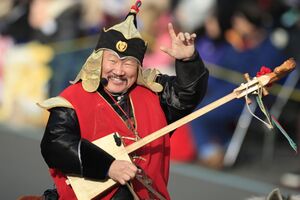
The traditional music of Daxia is called Agon and it mostly revolves around the use of percussion instruments and wooden flutes, without any voice accompaniment; as such Agon is typically loud and almost monotonous music. In the past Agon diverged into many variants such as religious Agon music which incorporated the use of metal bells to add new sounds or the Imperial Agon orchestras which added the novelty of human singing. Later brass instruments such as trumpets and trombones began to be introduced to Agon, creating new variations and schools of Agon.
The expansion of imperial rule into the steppe brought the millenarian Degei tradition of throat singing to Daxia, a singing style which meshed well with the established Daxian percussion music. Master throat singers are extremely well regarded and feted in Daxian high society. The most famous of the Daxian throat singing masters of today is Dovukai Mongush, of great national fame.
In the 1960's the republican government of the time introduced 'Morale Music' that was allegedly designed to buoy the morale of the people during a time of economic hardship. Morale music was inspired in Agon in that it was without any human voice accompaniment or lyrics to follow, but instead it was either purely instrumental or a series of abstract electronic beeps. For many years Morale music was blasted across Daxian towns and cities through the radio, a dedicated television channel and mounted bugles on street lamps. Morale music was totally discontinued in 1985 but the PDD might be reintroducing it in certain areas. The current anthem of Daxia is a modern example of Morale music.
Media
See also: Daxian News Network
Mass media is of great importance to the Daxian government, and for this reason it is not merely seen as a way to transmit news to the public but as an instrument of state control. The instrumentalization of the news began as soon as the PDD climbed into the driver's seat. By the early 1990's the government had begun to both loosen and lose its control of the media, who in decades prior had been ironclad in their loyalty to the system. The PDD quickly saw this editorial freedom as completely unacceptable and counterproductive to its long term goals. The security organs began a fierce 'downsizing' of the various media conglomerates of Daxia until only nubs remained. These remnants were taken over by the state and consolidated into the Daxian News Network, a mass media company that would become a behemoth under government tutelage. DNN today controls the news in every format be it television, radio, newspapers, magazines and online; it owns large media companies in neighboring Canpei, Rusana and Tanhai allowing it to influence opinions and political developments in those societies.
Economy
Main Article: Economy of Daxia
Overview

The Democratic Republic of Daxia possesses a mixed economy that combines elements of both a traditional and planned economy. While its GDP per capita of around $33,000 puts it squarely in the middle of the pack for individual incomes, its total national GDP of $23 trillion makes it one of the larger economies in the eastern part of the world. Most sectors of the economy; be it agriculture, manufacturing, defense, are dominated by a few oversized companies which often have sizable built in advantages over exterior competitors seeking to enter the Daxian markets. While there have been steps towards economic liberalization in the past decades such as reducing the mandatory, the State maintains a firm monopoly over many sectors of the economy seen as strategic such as the energy, communications and mining sectors while keeping in place at times not so subtle preferential policies towards native companies. Coming out of an economic downturn in the late 1990's, the opening of new markets and acquisition of vast natural resources due to the aggressive expansion into Crona has seen a massive expansion of economic activity in the present day. While not openly recognized, foreign experts assess up to ten percent of the national economy is controlled by members of the ruling Party through a vast network of companies both fictitious and real, with sums of money in the billions of lira remaining outside the purview of the tax authorities. The complete blurring of divisions between the Daxian state and the ruling party make getting detailed information nigh impossible. The Central Bank of Daxia(CBC) regulates private banks, prints currency and manages monetary policy with great emphasis placed on maintaining stable prices. The Central Bank is also in possession of the national gold reserves, maintaining several undisclosed locations for this purpose. The national currency is the Daxian Lira (ç).
Agriculture

The agricultural sector of Daxia, plays a pivotal role in ensuring food security and sustenance for its population. Blessed with fertile lands and a favorable climate, Daxia boasts a thriving agricultural industry. The nation's diverse topography supports the cultivation of a wide range of crops, including grains, fruits, and vegetables, making it self-sufficient in terms of food production. One of the mainstays of Daxia's agriculture sector is the cultivation of staple food crops. Farmers diligently grow crops such as rice, wheat, corn, and potatoes, which form one of the foundation of the nation's diet. These crops are carefully nurtured through advanced farming techniques and modern irrigation systems, ensuring optimal yields and high-quality produce. The government actively promotes sustainable agricultural practices, encouraging farmers to adopt eco-friendly methods that minimize environmental impact while maximizing yields and productivity.
In addition to staple crops, Daxia also places a significant emphasis on the production of fruits and vegetables. The nation takes pride in its orchards and gardens, which yield a bountiful harvest of apples, oranges, berries, and a variety of leafy greens for export. Daxian farmers employ innovative techniques like hydroponics and vertical farming to maximize crop yields and overcome limitations of land availability. The nation's commitment to agricultural diversity ensures a rich and varied diet for its citizens, promoting good health and well-being across the population. Overall, the agricultural sector of Daxia thrives on the cultivation of food crops, providing sustenance, economic stability, and nutritional security to its citizens. Through a combination of traditional wisdom and modern farming practices, Daxian farmers continue to adapt and innovate, ensuring the nation's food security even in the face of changing climates and market demands.
Meat Sector
Main Article: Meat Sector of Daxia

The Daxian meat industry is the largest in Alshar. The Daxian beef and pork market has an estimated value of 700 billion taler, owing to the Daxian diet traditionally being very heavy on meat consumption. Favorable industry conditions include vast grazing areas, government subsidies, technical help and campaigns to promote meat eating. Growth and demand of the sector is being fueled by the introduction of meat cuts into north Crona diets via new retail channels, the availability of extra grazing areas in Xisheng and Canpei and favorable export agreements with various international clients. The majority of the sector's leading companies are members of the Federation of Daxian Beef Producers, a cartel like organization that controls most commercial aspects of the beef industry and regulates meat prices. Animal genetic modification to improve meat yields is a field that has received great attention by the industry and scientific community. Genetic engineering by meat producers has given rise to so called megacows and megapigs, animals between 30-40% larger than the average. As stated by a scientist involved one of the goals of the program is to 'make pigs as big as cows and cows as large as bears'.
In recent years the breeding of the Daxian giant rabbit for meat consumption has also emerged as a unique and successful agricultural venture. Recognizing the potential of these oversized rabbits as a sustainable source of protein, Daxian farmers and agricultural authorities have teamed up and developed specialized breeding programs to cater to the growing demand for rabbit meat. These giant rabbits, selectively bred for their large size and rapid growth, offer a promising solution to meet the nation's increasing protein needs. The breeding process involves meticulous selection of parent rabbits with desirable traits, such as fast growth rate, muscular build, and efficient feed conversion. Farmers carefully manage the breeding program to ensure the health and well-being of the rabbits, providing them with a balanced diet and spacious enclosures to promote optimal growth. Additionally, veterinary care and regular monitoring are provided to maintain the overall welfare of the rabbits. The meat of these giant rabbits is tender and flavorful, making it a sought-after choice in Daxia's culinary scene and contributing to the nation's food security goals. With the breeding of giant rabbits gaining popularity, Daxia has witnessed the emergence of dedicated rabbit farms across the country. These farms employ advanced techniques and infrastructure to facilitate large-scale production while adhering to ethical and sustainable farming practices. As a result, Daxia's rabbit meat industry has not only created a new avenue for agricultural prosperity but has also helped to diversify the nation's culinary offerings, satisfying the palates of its citizens and potentially even becoming an export commodity.
Energy
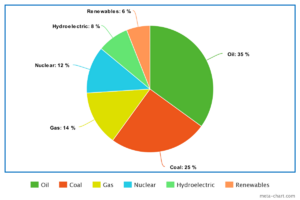
The Daxian economy relies on four main sources of energy to fulfill its needs. The first main source is oil which represents 35% of Daxian energy consumption. Domestic oil production which presently stands at 858,000,000 oil barrels per year and covers around 45% of a total oil consumption of 1,906,000,000 barrels per year, with the rest of oil needs met by foreign suppliers. The Ministry of Energy has a stated goal od meeting two thirds of the energy demand with domestic sources by the year 2050, as new offshore oil fields being operations in addition to the inputs from several oil fields being explored in Crona.
Close behind oil as a source of energy is coal. Daxia is one of the largest producers of coal worldwide and one of the largest remaining users of coal for energy generation with some eight hundred coal power plants in operation as of 2025. Previously representing the largest share of energy production, it has lost ground to other energy sources, especially to nuclear and natural gas power generation. Permits for new coal plants are now subject to strict review by the National Board of Energy, a situation that was much more lax in past decades. The next tier is composed of nuclear and natural gas. Gas being a much less polluting alternative to coal, the government has been open to giving more fiscal advantages to gas companies to explore and develop gas fields with the purpose of reducing coal usage and related pollution in the future. Gas imports stand at 50 billion cubic meters in 2025 while domestically it produced 45 billion cubic meters in the same period.
Nuclear energy is also rising in importance for the energy sector. The state owned company Daxian Nuclear Corporation currently operates 35 nuclear reactors with an installed capacity of 36.5 GW and an extra 17 GW to be gained from projects currently under construction. Derived from the secret nuclear weapons program, Daxia has the ndigenous technical capacity and supply chains of advanced nuclear technology to build and operate nuclear reactors relying entirely on its own resources. The Daxian Nuclear Corporation is currently in talks to build and operate nuclear reactors for civilian energy generation with certain commercial partners.
Banking
Industry
Manufacturing
vast crockery factories, Rusana-Canpei-Daxia economic zone/corridor
Rising Crescent Economic Corridor
The Canpei-Rusana-Daxia Economic Corridor, officially named as the Rising Cresent Economic Corridor is an infrastructure development project initiated by the Daxian government. This corridor aims to enhance regional connectivity, stimulate economic growth, and foster cooperation. One of the primary focuses of this collaboration is the development of transport and road infrastructure; a crucial concern for landlocked Rusana and Canpei, airports, the development of heavy industry, and energy generation, which are crucial pillars for the corridor's success. The construction of an extensive transport network forms the backbone of the economic corridor. Modern highways, railways, and ports are planned to connect the three nations, facilitating the seamless movement of goods, services, and people. By improving transportation infrastructure, the corridor aims to reduce logistics costs, enhance trade efficiency, and attract foreign investment. Furthermore, the nations collaborate to streamline customs procedures and harmonize regulations, promoting cross-border trade and economic integration.
Alongside transport infrastructure, the economic corridor places significant emphasis on the development of heavy industry. Joint investments in establishing industrial zones and manufacturing hubs within the corridor. These zones foster the growth of sectors such as steel production, automotive manufacturing, and machinery fabrication. The nations leverage their respective strengths and resources to create a synergistic industrial ecosystem, promoting technology transfer, job creation, and economic diversification. This heavy industry development also supports the construction of transport infrastructure by providing a local demand for construction materials and equipment. Energy generation plays a vital role in powering the economic corridor and fueling its industrial growth. Canpei, Rusana and Daxia collaborate on the establishment of energy projects, including hydroelectric power plants, solar farms, and wind turbines. The nations tap into their collective natural resources and renewable energy potential, striving for energy self-sufficiency and environmental sustainability. By fostering a reliable and affordable energy supply, the economic corridor attracts heavy industry investments, which in turn drive economic development and job creation.
Mining

Daxia has 135 types of minerals that have been discovered in its territory including 45 metals, 84 non metallic minerals and six types of gases. There is great prospecting potential for near two dozen metallic minerals including but not limited to coal, iron ore, manganese, chromite, copper, nickel, tungsten, lead, zinc, bauxite, tungsten, tin, molybdenum, antimony, nickel, gold, silver, lithium, pyrites, sulphurite, phosphate rock, potash, magnesite, uranium, boron, barite and handwavium. Daxia is ranked as a leading producer of many of these minerals and is looking to compound this advantage by partnering with international companies to deploy new mining technologies. The current largest operator of mines is Mimban Corporation, a partially government owned company that owns the largest number of coal and copper mines in Alshar.
Mining has seen such a boom and expansion that new regulations are being brought into place to better control the sector and clamp down on illegal practices. The 2026 mining code issued by the Ministry of Resource Extraction brought forth several changes such a the establishment of an iron ore national reserve, increase of tax benefits for low grade mines, various regulations to encourage prospecting of key minerals and improvements to the ore trading system and pricing mechanisms. It also established new penalties for inhuman practices. One example of said practices is that in the past mining companies were known to employ agencies that forcefully recruited people in debt to work in mines, in this way circumventing having to pay the high salaries and hazard policies that regular employees are entitled to, this practice is now forbidden. Underground mining towns are now restricted to five hundred workers maximum, mine foremen included.
Tourism

Tourism in Daxia is a developing sector of the economy. In 2028, Daxia received roughly 5.3 million international arrivals, up from 3.6 million arrivals in 2010. The authoritarian and secretive nature of Daxia's successive political regimes means that tourists were loath and wary of visiting and the government did very little to encourage a tourism industry to flourish. Only since the early 2000's has tourism gained official endorsement as part of Daxian soft power campaigns and to garner foreign exchange, with private enterprise taking the lead in opening up resorts and tourist developments. Heritage sites and historical locations, national parks and more conventional tourist spots such as beaches, ski resorts and casinos have slowly gained in popularity and international clientele.
The policy of assigning government minders to tourists was officially dropped in 2015 though many reports have surfaced of individuals reporting their suspicion of being monitored or spied upon from afar in online forums. Even with a relaxation of rules many regions and cities are still completely closed off to visitors. There are still limitations on who can visit as Daxia has blacklisted several countries such as Carna, whose passport holders are liable to be arrested if found within national borders.
Gambling
See also: Abachinko

Gambling has been a legal and a regulated activity since 1725 when the Qian government began issuing operation licenses for gambling houses in order to raise revenues. As part of its business empire, the South Seas Trading Company operated the largest gambling operations under its subsidiary company, the Daxian Society for Gambling and Recreation. The company's collapse led to an opening of the market to a plethora of new private gambling enterprises.
In the modern day hundreds of casinos operate all over the country, with some local economies heavily dependent on the taxation and jobs provided by such operations. One particularly popular modality of gambling are Abachinko parlors. Abachinko is an arcade game similar to pinball, different in that it uses multiple balls at once instead of only one. There are thousands of private Abachinko parlors with some 4 million machines in operation. Online gambling has also been taking off massively, with websites focusing on poker, sports betting, bingo and other modalities sprouting like fungi due to lack of regulation.
The exponential growth of the gambling sector and the fact that much of it is poorly regulated is having notoriously negative societal effects in Daxia such as an increase in organized crime, fraud and money laundering, gambling and substance addictions and predatory practices by gambling operators.
















